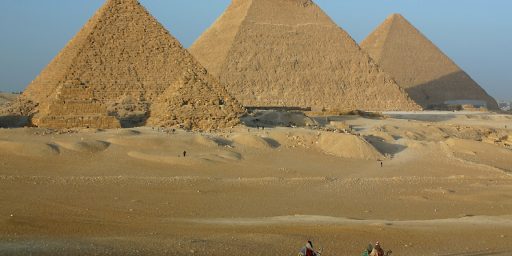Seventeen “Lost” Egyptian Pyramids Found
Apparently, there’s still some discovering left to do.
BBC News: (“Egyptian Pyramids Found By Infra-Red Satellite Images”)
Seventeen lost pyramids are among the buildings identified in a new satellite survey of Egypt.
More than 1,000 tombs and 3,000 ancient settlements were also revealed by looking at infra-red images which show up underground buildings.
Initial excavations have already confirmed some of the findings, including two suspected pyramids.
The work has been pioneered at the University of Alabama in Birmingham by US Egyptologist Dr Sarah Parcak.
She says she was amazed at how much she and her team has found.
“We were very intensely doing this research for over a year. I could see the data as it was emerging, but for me the “Aha!” moment was when I could step back and look at everything that we’d found and I couldn’t believe we could locate so many sites all over Egypt.
“To excavate a pyramid is the dream of every archaeologist,” she said.
The team analysed images from satellites orbiting 700km above the earth, equipped with cameras so powerful they can pin-point objects less than 1m in diameter on the earth’s surface.
Infra-red imaging was used to highlight different materials under the surface.
The ability of technology like this to uncover previously unknown archeological sites, not only in Egypt but elsewhere in the world, is something that is sure to uncover secrets that have been buried for thousands of years.





![Military Coup Underway In Egypt [Update: Morsi Deposed]](https://otb.cachefly.net/wp-content/uploads/2011/02/egypt-flag3-512x256.gif)
Cool. When can I log onto the sattelite?
Greetings:
I seem to raise a bit of a smirk when I come across information about the ongoing archaeology in Egypt. It seems to me that the Egyptians involved see this as a moneymaker for their tourism industry and so are forever trotting out their minister of antiquities, Hawawi or some such name, to PT Barnum-ize the most recent discoveries. Yet, I sense an underlying conflict between their current Islamomania and the pre-Mohammed age of the Pharaohs. And then, of course, there’s the little tidbit about how it was that bunch of, in Edward Said’s ideology, colonizing “Orientalists” who got the ball rolling and continue to do the heavy lifting and paying.
Gotta love them Arabs. Welcome to the souk.
Egypt isn’t the only place where this technology is being applied. One location that’s particularly well-suited to its use and where there may be some really interesting stuff is on the Arab Peninsula. Recent research on “Out of Africa” hypothesis strongly suggests that the Arab Peninsula was a route from Africa to Asia for our earliest ancestors.
The second space shuttle mission carried a radar system that helped map some of the ancient trading routes in Arabia. Using that and some other satellite resources the ‘lost city’ of Iram was found in Oman in the 90’s.